
The president of the Philippines is the head of state, head of government and chief executive of the Philippines. The president leads the executive branch of the Philippine government and is the commander-in-chief of the Armed Forces of the Philippines.
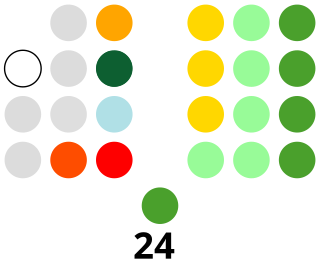
The Congress of the Philippines is the legislature of the national government of the Philippines. It is bicameral, composed of a lower body, the House of Representatives, although colloquially the term "Congress" commonly refers to just the latter, and an upper body, the Senate. The House of Representatives meets in the Batasang Pambansa in Quezon City while the Senate meets in the GSIS Building in Pasay.
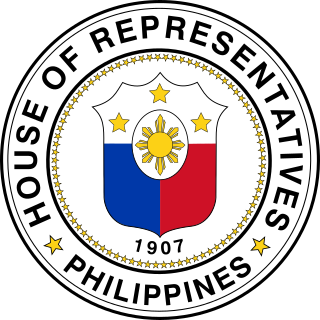
The House of Representatives of the Philippines is the lower house of Congress, the bicameral legislature of the Philippines, with the Senate of the Philippines as the upper house. The lower house is usually called Congress, although the term collectively refers to both houses.

The Senate of the Philippines is the upper house of Congress of the bicameral legislature of the Philippines with the House of Representatives as the lower house. The Senate is composed of 24 senators who are elected at-large under plurality-at-large voting.
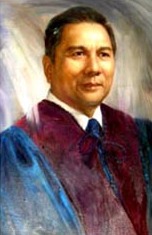
Marcelo "Celing" Briones Fernan was a Filipino lawyer and political figure. He is the only Filipino to have served as both Chief Justice of the Supreme Court and as Senate President. He is also the third Filipino to have headed both the judicial and legislative branches of government, after Querube Makalintal who served as Chief Justice and Speaker of the Batasang Pambansa in the 1970s, and José Yulo, who served as Chief Justice and Speaker of the House of Representatives before 1946.

The vice president of the Philippines is the second-highest official in the executive branch of the Philippine government and is the first in the presidential line of succession. The vice president is directly elected by the people and is one of only two nationally elected executive officials, the other being the president.
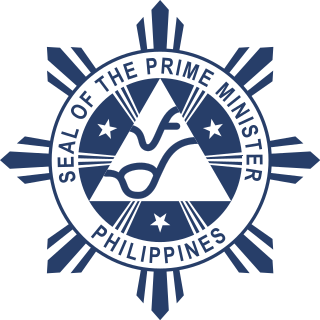
The prime minister of the Philippines was the official designation of the head of the government of the Philippines from 1978 until the People Power Revolution in 1986. During martial law and the fourth republic, the prime minister served as the head the Armed Forces of the Philippines. A limited version of this office, officially known as the President of the Council of Government, existed temporarily in 1899 during the First Philippine Republic.

The State of the Nation Address is an annual address by the president of the Philippines to a joint session of the Congress of the Philippines. Mandated by the 1987 Constitution, the speech is delivered every fourth Monday of July at the Plenary Session Hall of the Batasang Pambansa Complex in Batasan Hills, Quezon City.
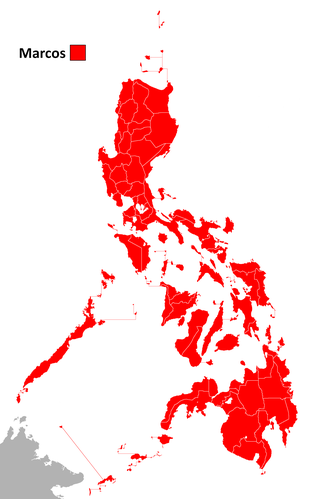
The 1981 Philippine presidential election and national referendum was held on June 16, 1981. President Ferdinand E. Marcos of the Kilusang Bagong Lipunan (KBL) defeated retired general and World War II veteran Alejo Santos of the Nacionalista Party in a landslide victory. Most opposition parties boycotted the election as a sign of protest over the 1978 election for the Interim Batasang Pambansa, which they condemned as fraudulent. At the same time, a national referendum was held on the question in holding elections for barangay elections in 1982.
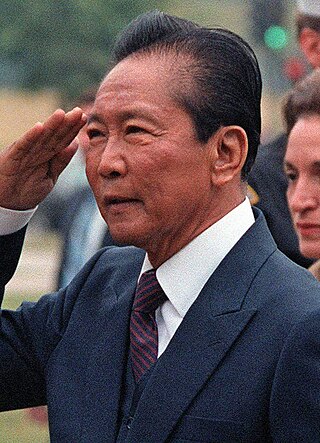
A parliamentary election was held in the Philippines on April 7, 1978, for the election of the 165 regional representatives to the Interim Batasang Pambansa. The elections were participated in by the leading opposition party, the Lakas ng Bayan (LABAN), which had twenty-one candidates for the Metro Manila area while the leading candidate was the jailed opposition leader Ninoy Aquino, and the Marcos regime's party known as the Kilusang Bagong Lipunan (KBL), which was led by the then-First Lady Imelda Marcos. Ninoy was allowed to run by his fellow partymates under the Liberal Party, who boycotted the election and was not allowed to campaign, and so his family campaigned for him. The night before the election on April 6, 1978, a noise barrage was organized by the supporters of (LABAN) which occurred up to dawn.
The Interim Batasang Pambansa was the legislature of the Republic of the Philippines from its inauguration on June 12, 1978, to June 5, 1984. It served as a transitional legislative body mandated by the 1973 Constitution as the Philippines shifted from a presidential to a semi-presidential form of government.
This list of presidential elections in the Philippines includes election results of both presidential and vice presidential elections since 1899 with the candidates' political party and their corresponding percentage.
The Regular Batasang Pambansa, or the First Batasang Pambansa, was the meeting of the Batasang Pambansa from the beginning of its session on July 23, 1984 until it was abolished by President Corazon Aquino on March 25, 1986.
A national referendum-plebiscite was held on October 16–17, 1976 in the Philippines in which the majority of the barangay voters approved the continuation of Martial Law and ratified the proposed amendments to the Constitution substituting the Regular Batasang Pambansa with the Interim Batasang Pambansa, pursuant to Presidential Decrees Nos. 991, 1031, and 1032.
The Constitution of the Philippines is the constitution or the supreme law of the Republic of the Philippines. Its final draft was completed by the Constitutional Commission on October 12, 1986, and ratified by a nationwide plebiscite on February 2, 1987.
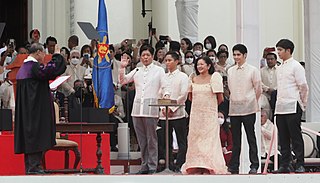
The inauguration of the president of the Republic of the Philippines is a ceremony marking the commencement of the six-year term of a president of the Philippines, who is both head of state and head of government. The inauguration is performed on June 30, as mandated by the 1987 Constitution. Under the older 1935 Constitution, the date was December 30, which is also Rizal Day; the last inauguration held on the older date was Ferdinand Marcos' second one on December 30, 1969. The most recent public presidential inauguration ceremony was that of President Bongbong Marcos, who began his six-year term in office on Thursday, June 30, 2022.

The following is the official canvassing of votes by the Congress of the Philippines for the 2022 Philippine presidential and vice presidential election. The canvassing started on May 24, 2022 and ended a day later, making it the fastest congressional canvassing process in Philippine electoral history.















